Enhancing Visual Exploration through Augmented Gaze: High Acceptance of Immersive Virtual Biking by Oldest Olds
- PMID: 36767037
- PMCID: PMC9914324
- DOI: 10.3390/ijerph20031671
Enhancing Visual Exploration through Augmented Gaze: High Acceptance of Immersive Virtual Biking by Oldest Olds
Abstract
The diffusion of virtual reality applications dedicated to aging urges us to appraise its acceptance by target populations, especially the oldest olds. We investigated whether immersive virtual biking, and specifically a visuomotor manipulation aimed at improving visual exploration (augmented gaze), was well accepted by elders living in assisted residences. Twenty participants (mean age 89.8 years, five males) performed three 9 min virtual biking sessions pedalling on a cycle ergometer while wearing a Head-Mounted Display which immersed them inside a 360-degree pre-recorded biking video. In the second and third sessions, the relationship between horizontal head rotation and contingent visual shift was experimentally manipulated (augmented gaze), the visual shift being twice (gain = 2.0) or thrice (gain = 3.0) the amount of head rotation. User experience, motion sickness and visual exploration were measured. We found (i) very high user experience ratings, regardless of the gain; (ii) no effect of gain on motion sickness; and (iii) increased visual exploration (slope = +46%) and decreased head rotation (slope = -18%) with augmented gaze. The improvement in visual exploration capacity, coupled with the lack of intolerance signs, suggests that augmented gaze can be a valuable tool to improve the "visual usability" of certain virtual reality applications for elders, including the oldest olds.
Keywords: assisted living facility; augmented gaze; healthy aging; motion sickness; oldest old; technology acceptance; virtual biking; virtual reality; visual exploration.
Conflict of interest statement
The authors declare no conflict of interest. The funders had no role in the design of the study; in the collection, analyses, or interpretation of data; in the writing of the manuscript; or in the decision to publish the results.
Figures
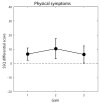
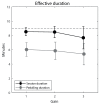
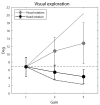
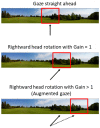


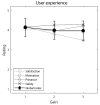
Similar articles
-
Effects of Immersive Virtual Reality Headset Viewing on Young Children: Visuomotor Function, Postural Stability, and Motion Sickness.Am J Ophthalmol. 2020 Jan;209:151-159. doi: 10.1016/j.ajo.2019.07.020. Epub 2019 Aug 1. Am J Ophthalmol. 2020. PMID: 31377280
-
Development of an 360-degree virtual reality video-based immersive cycle training system for physical enhancement in older adults: a feasibility study : Development of immersive virtual cycle for older adults.BMC Geriatr. 2021 May 22;21(1):325. doi: 10.1186/s12877-021-02263-1. BMC Geriatr. 2021. PMID: 34022789 Free PMC article.
-
Comparison of visual fatigue caused by head-mounted display for virtual reality and two-dimensional display using objective and subjective evaluation.Ergonomics. 2019 Jun;62(6):759-766. doi: 10.1080/00140139.2019.1582805. Epub 2019 Mar 14. Ergonomics. 2019. PMID: 30773103
-
Virtual Reality-A Supplement to Posturography or a Novel Balance Assessment Tool?Sensors (Basel). 2022 Oct 17;22(20):7904. doi: 10.3390/s22207904. Sensors (Basel). 2022. PMID: 36298254 Free PMC article. Review.
-
Sensation of presence and cybersickness in applications of virtual reality for advanced rehabilitation.J Neuroeng Rehabil. 2007 Sep 25;4:34. doi: 10.1186/1743-0003-4-34. J Neuroeng Rehabil. 2007. PMID: 17894857 Free PMC article. Review.
Cited by
-
Human Factors, Human-Centered Design, and Usability of Sensor-Based Digital Health Technologies: Scoping Review.J Med Internet Res. 2024 Nov 15;26:e57628. doi: 10.2196/57628. J Med Internet Res. 2024. PMID: 39546781 Free PMC article.
References
-
- Høeg E.R., Povlsen T.M., Bruun-Pedersen J.R., Lange B., Nilsson N.C., Haugaard K.B., Faber S.M., Hansen S.W., Kimby C.K., Serafin S. System Immersion in Virtual Reality-Based Rehabilitation of Motor Function in Older Adults: A Systematic Review and Meta-Analysis. Front. Virtual Real. 2021;2:30. doi: 10.3389/frvir.2021.647993. - DOI
-
- Sakaki K., Nouchi R., Matsuzaki Y., Saito T., Dinet J., Kawashima R. Benefits of VR Physical Exercise on Cognition in Older Adults with and without Mild Cognitive Decline: A Systematic Review of Randomized Controlled Trials. Healthcare. 2021;9:883. doi: 10.3390/healthcare9070883. - DOI - PMC - PubMed
Publication types
MeSH terms
LinkOut - more resources
Full Text Sources
Other Literature Sources
Medical

